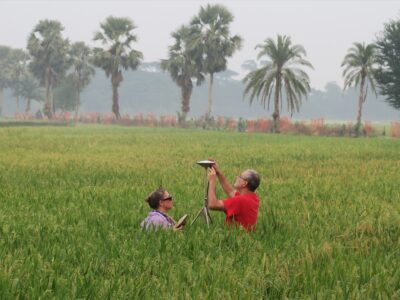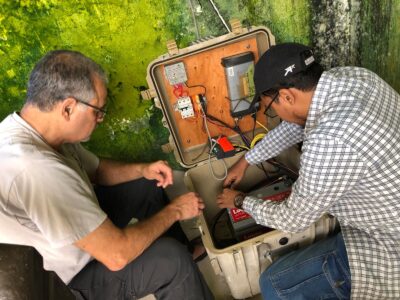
The last two days have been a little different as I spent much of them in Khulna rather than at the site. Since the Islam family does not have electricity, Hafizul would have to carry the expensive EDM (Electronic Distance Meter) and laptop back and forth to Khulna University to charge. However, we have an extra solar panel because we thought we would need two at Jamalganj. We decided to buy the equipment to set up another solar panel power system. It will be used to charge the EDM and laptop for the once per week measurements. The rest of the time, the family can use it for power. It is only a 40W solar panel, so it won’t give them much, a small light compact fluorescent bulb. They’d like more. The kids already want a TV, but it won’t produce enough power, even if they could afford it. Yesterday morning Scott N, Dhiman, Kevin and I went shopping while Scott D., Humayun and Shaon went to the site. We eventually found a place with what we needed in stock, although the prices were not that good. The battery company we generally use in Dhaka didn’t have the correct size and it would take too long for them to get it. It took long discussion about what we needed, haggling over prices, drinking tea and eating cookies, but eventually we closed the deal, a 55 Ah battery, a solar regulator and a power invertor to convert to 220V. However, it took all morning.

We drove to the site, where good progress had been made on building the forms for the concrete pillars. But, I would not get to stay. Humayun needed to go to Khulna University to see if he could get the GPS and seismic station running again. I hadn’t been to the Khulna stations before, so I went, as did Kevin and Dhiman. We met Rakib, who looks after the seismic station. The computer is in a plain but functional room. The sensor and recorder are down in the basement. After hovering over the recorder with a laptop old enough to still have a SCSI port for communicating with the old equipment, he got it working. IRIS (Incorporate Research Institutions for Seismology), who lends out pooled equipment for seismic experiments, started a program lending out retired, obsolete recorders to developing countries. We got one of the first awards for Bangladesh. It had failed and a placement from Won-Young Kim could not be gotten to work, but Humayun managed it. What was fascinating, was we saw two of the four students that had come out to the site. At university, they were dressed demurely in robes and head coverings, very different from the brightly colored outfits they wore for fieldwork.
Next over to the Urban Planning Department that looks after, or mostly neglects the GPS that they don’t understand. After finding the young professor who in in charge of the room with the receiver, we saw the sad state. The battery that powers it was so run down, the IPS could not charge it. It has been a long time since this unit has collected data. However, it is now important as the closest station to the site. Before it went down it showed the rapid subsidence rate of ~9 mm/year. The university is built over a thick peat layer. One building sank 1 foot in the years after it was built, another building was designed with a rounded ship’s bottom to float over the peat. The powering system we used in 2003, when the GPS station was installed was poor and tends to wear out the battery. I brought new power regulators for all of the 2003 stations with me this trip, but they are still in Dhaka. Humayun or Dhiman will have to come back to redo the station power system. Eventually, the station will be moved to the other building where Rakib can more closely watch over it. That done, a meeting with the department chair, who was stuck in another meeting. More tea and cookies and discussions with the young professor who now understands what we are doing. We gave up and went back to the site, getting there just in time for the others to be backing up to leave. While we were gone 5 of the columns had been poured along with the base of the deep well. Giving the cement in the deep well time to dry, it was not yet tested to see if the installation worked.
This morning, more errands and we split again. Errands that became much harder when we realized it was Friday. Banks were closed and I was running out of cash. Couldn’t cash my traveler’s checks, couldn’t get an ATM to give me money. Here, all ATMs have guards, so many were closed. Somehow a manned ATM seems to defeat the purpose of an ATM to me. Luckily I found a enough Euros in my wallet to support us until the banks open on Sunday.

We also ran into problems with our workshop. We were supposed to meet him this morning to build a frame to hold the solar panel at the top of the pole we will install for it. But he was closing and leaving Khulna. We hunted for an open workshop. Most open ones were working overtime on incomplete jobs and could take the time to do one for us. Finally on the fourth try, we found one. Worked together to get a design that would work. Then they built it be hand and eye, cutting the iron with a hammer and chisel, measuring, welding. The clamp that will hold the bottom to the pole was cut, bent and rounded by hand using a section of railroad rail with special tool pieces added for cutting and bending the iron by hand. Great to watch. There are loads of workshops with this here all manufacturing things by hand and they are good at it. We got our frame. It can attach to the pole and should hold the solar panel at the proper angle and withstand the monsoon. Total cost for 90 minutes work and the metal – $11.27.

Back to the site with water and lunch snacks. The last column is done and the deep well is good. All 6 are working. Scott D. is working on the calibration. Humayun and Kevin leave to go back to Dhaka. We will see them in a few days. Now the poles to carry the GPS antenna cable must be put up across the shrimp pond, not the most sanitary place. The solar panel pole must be put up two. We need all the construction to be done today. Dhiman wades into the pond with the Sonotube concrete from. There are unknown in Bangladesh, but Scott D. used 3 of them to protect the fiber spools. They are sunk into the mud and the mud dug out. 20-foot poles are put up in the middle and 5 people work it 10 feet into the ground. We threaded the cable through first, as there is no way to reach the top now. All the cables have to be attached to the solar panel before it is put up at the edge of the house platform. It takes Scott N. and I a while, but it is done. Dhiman and then Mukul dig out a hole for its concrete base. We then lift its heavy pole topped with the solar panel assembly, but we cannot get it all the way into the ground. Scott N. jumps up and hangs off the pole. The extra weight is what we need, it slowly sinks to the correct depth. Mukul and the others wade through the muck, filling the forms with concrete. Meanwhile Scott D. had calibrated 3 of the wells and instructed Hafizul on the equipment use, with his younger brother following every step. It is getting late. Do we continue? Mount the other solar panel on the roof? The clouds break into rain. The workday is over. We huddle at the house talking to the Islam family unti the rain stops and we head to the car. One more day of finishing up and then back to Dhaka. I don’t want to claim success until everything is actually done, but it is looking good and Bangladesh beat England in cricket tonight for a much needed win.





Iˇve read some excellent stuff here. Certainly value bookmarking for revisiting. I surprise how much attempt you put to create this kind of wonderful informative website.
portafogli louis vuitton http://www.grandiveggenti.org/img/common/louis-vuitton.asp?p=portafogli-louis-vuitton.html
I do trust all the ideas you’ve introduced on your post. They’re very convincing and can certainly work. Still, the posts are too short for newbies. May you please lengthen them a little from subsequent time? Thanks for the post.
woolrich woolrich http://www.gruppoethos.it/images/woolrich/woolrich.asp?p=woolrich-woolrich.html